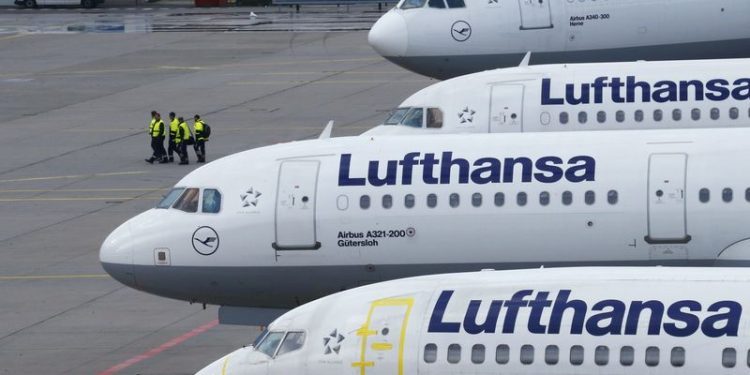Investing.com — Shares of Lufthansa (ETR:LHAG) traded lower on Tuesday following its third-quarter results.
At 5:10 am (0910 GMT), Lufthansa was trading 2.7% lower at €6.682.
While the airline posted a modest earnings beat, analysts at J.P. Morgan attribute the positive surprise to what they term “lower quality” factors, such as reduced administrative expenses and favorable foreign exchange impacts, rather than core operational improvements.
The group reported earnings before interest and taxes of €1.34 billion, narrowly surpassing consensus by about 2%.
As per J.P. Morgan, this slight beat in third-quarter earnings offers limited optimism due to its dependence on cost adjustments rather than structural growth or improved revenue quality.
Passenger revenue per available seat kilometer fell by 2.7%, which was marginally better than expected, though the airline continues to face persistent pricing pressure, particularly in the Asia-Pacific and Americas regions.
Excluding fuel, Lufthansa’s cost per available seat kilometer rose by 4.5%, driven largely by increased personnel and maintenance expenses.
This uptick in operating costs, coupled with lackluster demand in key regions, has highlighted structural challenges within Lufthansa’s cost efficiency and pricing strategy.
Going forward, Lufthansa’s guidance suggests stable—if unexciting—earnings expectations. The airline has maintained its 2024 EBIT target in the range of €1.4 to €1.8 billion, implying a modest 2024 EBIT midpoint in line with consensus at approximately €1.6 billion.
Yet analysts at J.P. Morgan warn that this target may prove challenging to achieve, as Lufthansa anticipates mid-single-digit declines in passenger RASK next year.
This revised guidance reflects heightened pressure from a strong year-on-year comparison to late 2023, further complicated by ongoing unit revenue weakness.
“We believe Q4 will now need to see an improvement in the trend to reach the full year guidance of a low-single-digit increase for the full year. This looks challenging against the backdrop of less capacity growth (fix costs spread over less “units”),” said analysts at Stifel in a note.
On the cost front, Lufthansa has announced a series of turnaround initiatives totaling €1.5 billion aimed at achieving a more competitive cost structure by 2026.
With 65% of these initiatives focused on cost reductions and 35% on revenue generation, the airline is targeting greater efficiency through operational restructuring and modest revenue-enhancement strategies.
However, J.P. Morgan cautions that these efforts may face limitations as Lufthansa grapples with persistent cost inflation and a widening productivity gap compared to pre-pandemic levels.
Despite the airline’s attempts to stabilize pricing and control expenses, the external environment remains challenging, and analysts do not foresee significant tailwinds to reverse recent trends. With 2024 capacity growth expected at 10% year-on-year, Lufthansa is preparing to expand at a faster rate than its network carrier peers.
“We upgraded Lufthansa recently from Sell to Hold, as we expect a rather solid year- end and are encouraged by the way Lufthansa is now reacting to price weakness by slowing down capacity growth to bring supply/demand into better balance. We also anticipate upcoming fuel cost benefits from falling spot prices,” said analysts at Stifel in a note.
This aggressive capacity ramp-up, however, could further dilute pricing power in an already competitive market.
As per J.P. Morgan, the delicate balance between supply and demand may hinder the carrier’s ability to sustain pricing, which remains a critical component of Lufthansa’s path to profitability.
Lufthansa currently trades at a discount to its historical valuation, with J.P. Morgan attributed this to the structural cost and demand-related headwinds that weigh on the airline’s outlook.
“We see some risks as reflected in an undemanding valuation, although we see some other European airlines offering more attractive prospects (for margins/ returns),” said analysts at RBC Capital Markets in a note.





